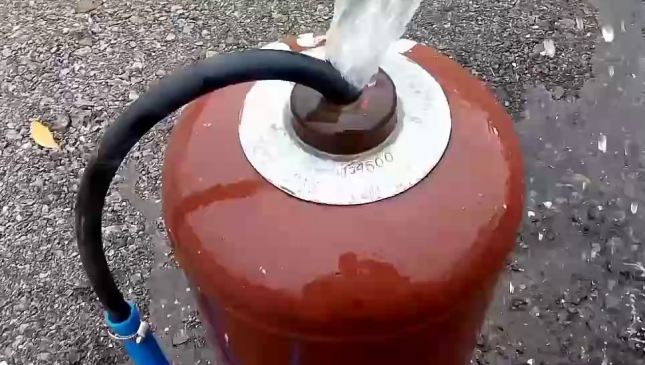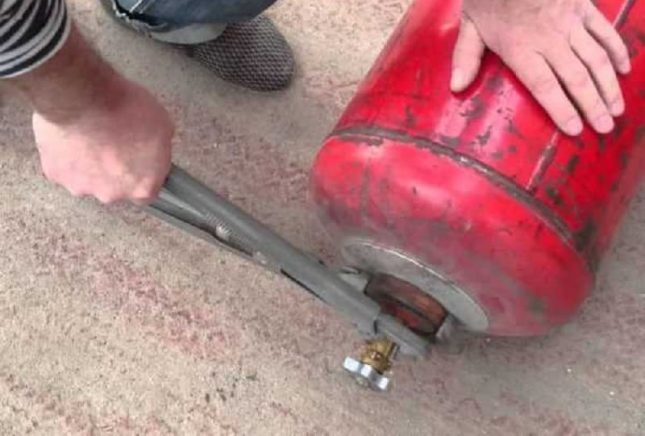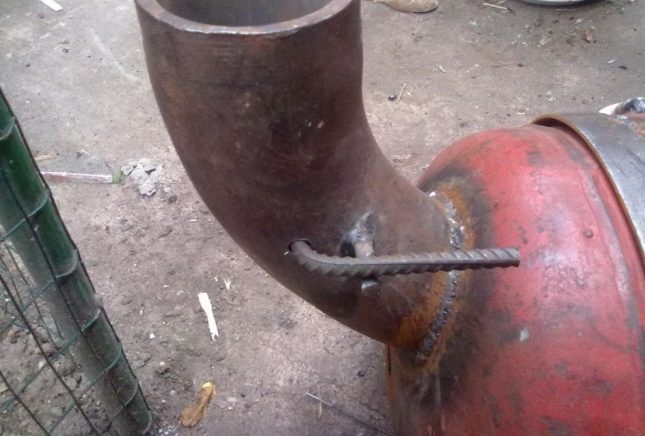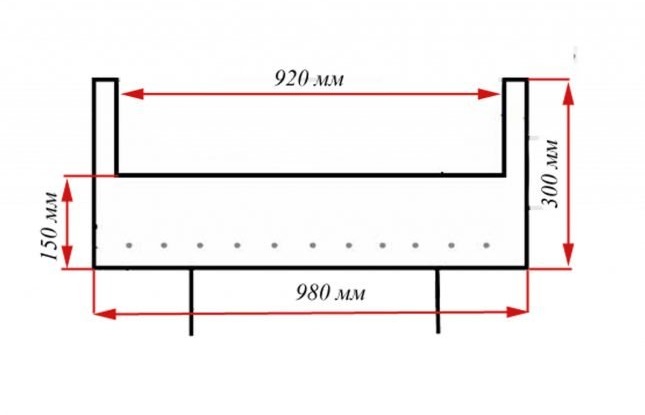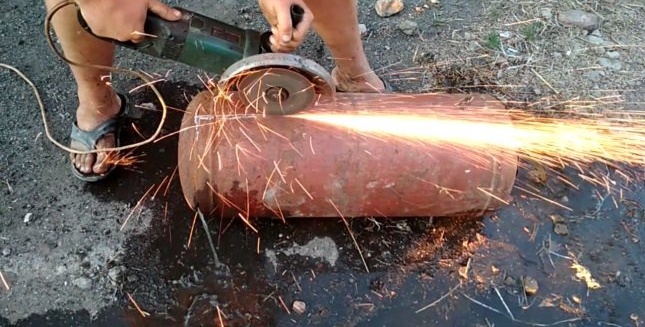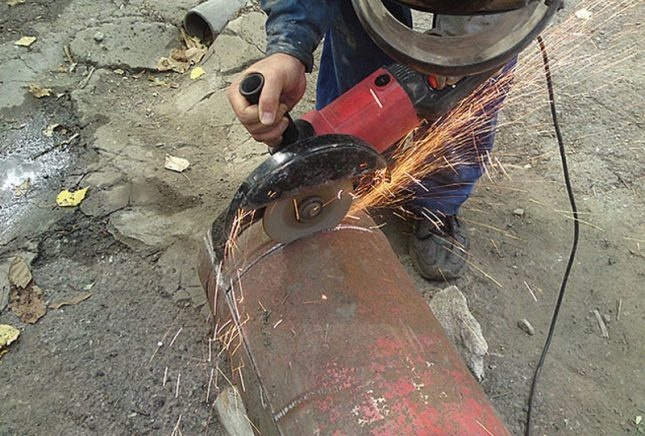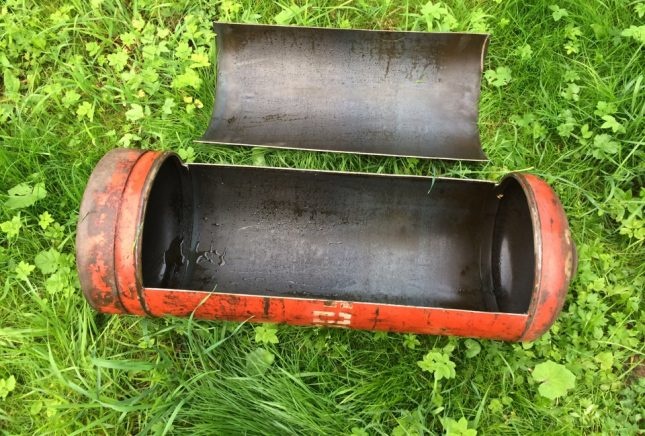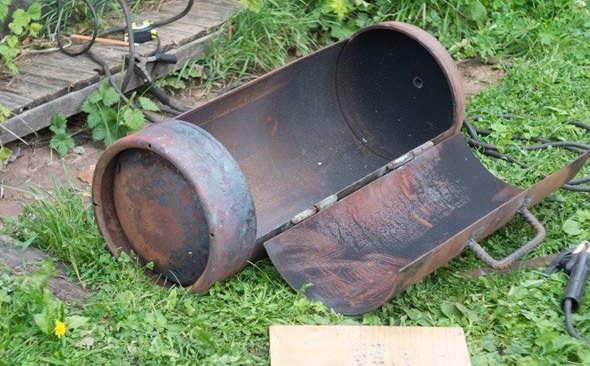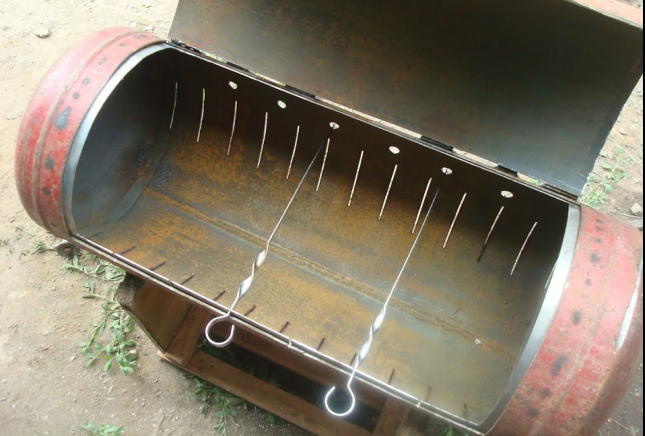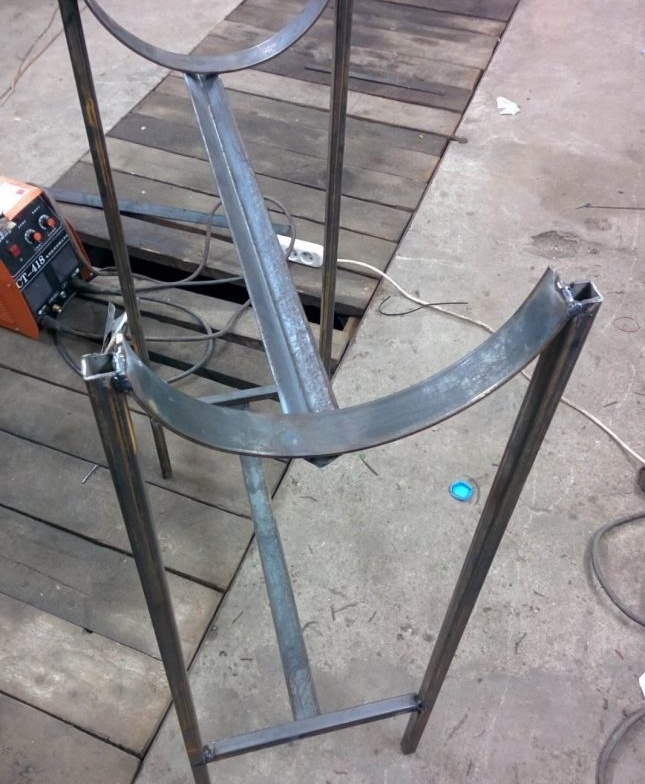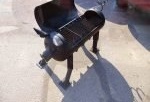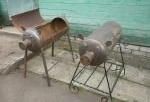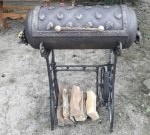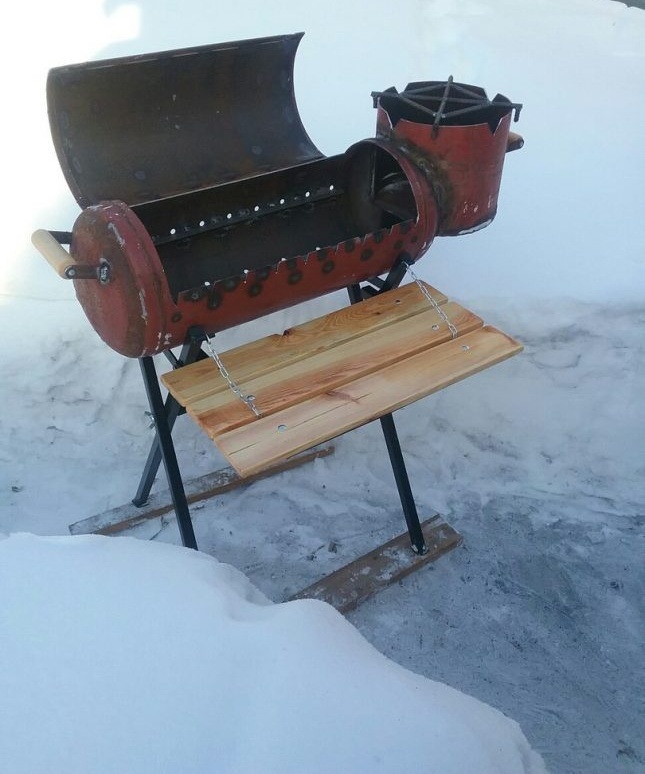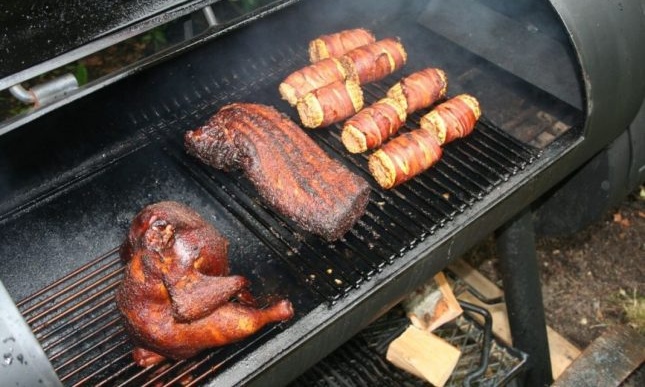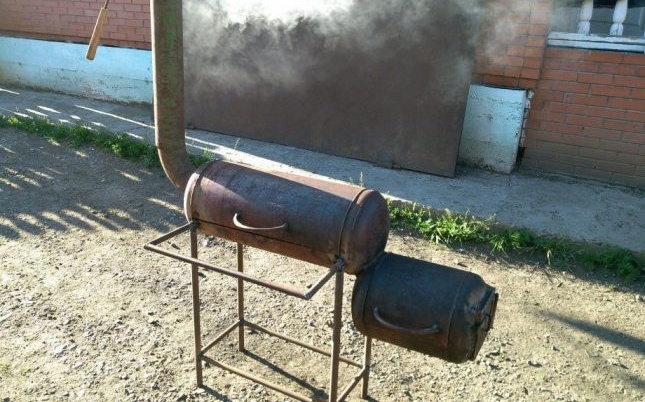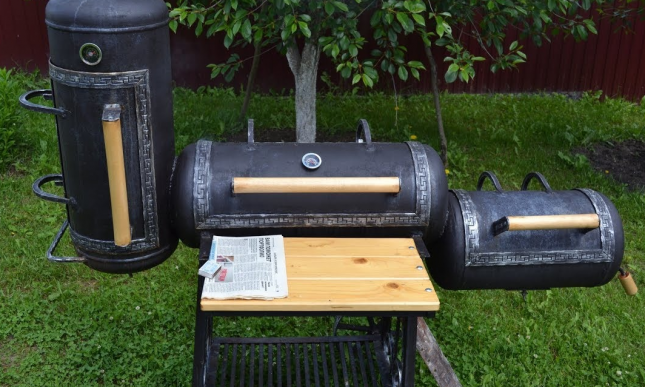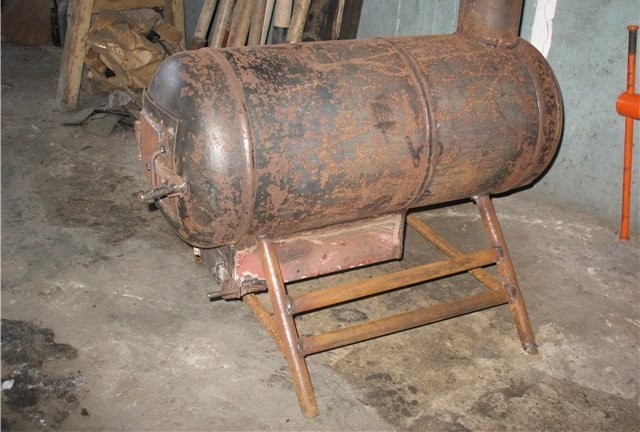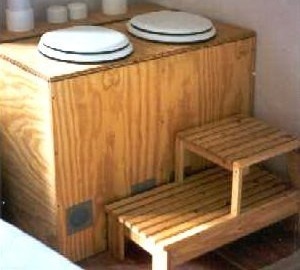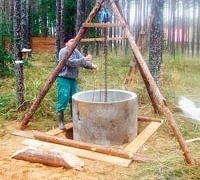Do-it-yourself barbecue grill: instructions and features
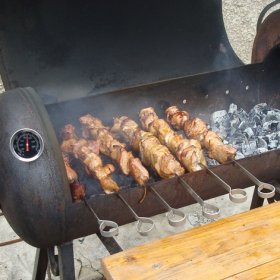
From gas cylinders, practical and reliable barbecue grills are obtained, as well as other grill options. Having studied the instructions, you can easily make them yourself.
Content
Pros and cons of homemade barbecue
The material and design of the cylinders determine the advantages of barbecues:
- thick walls of high-quality metal are resistant to high temperatures;
- multifunctionality - the made construction can be used for smoking or frying products, baking vegetables;
- ease of use - after cooking, the grill is covered with a lid, it is not necessary to extinguish the coals;
- saving - buying a cylinder is cheaper than buying sheets of metal, but often it’s not even necessary, since many people already have unnecessary containers on the farm;
- speed and ease of manufacture - the dimensions and design of the cylinders are such that it takes a minimum of steps to create a brazier, and special skills are not needed and all the work takes little time.
There are few drawbacks. Some do not like the large size, bulkiness of the design. Others consider as a minus the semicircular bottom of a homemade barbecue, inconvenient for igniting firewood.
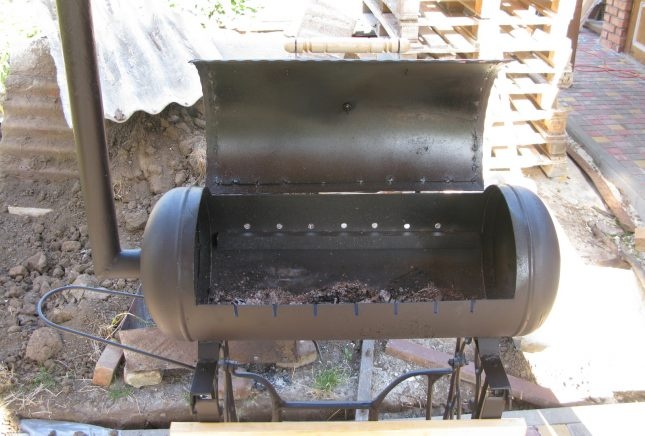
The spherical design of the barbecue is considered by some to be a plus (meat is evenly baked), and by others - a minus (the aroma of meat is not revealed)
Preparatory Activities
At this stage, choose a gas cylinder, prepare diagrams or drawings with dimensions, materials and tools.
Brazier diagram
This is a fairly simple structure. To create it, complex drawings are not needed, but it is desirable to make a diagram with dimensions. This will help determine the amount of materials required and plan the course of action.
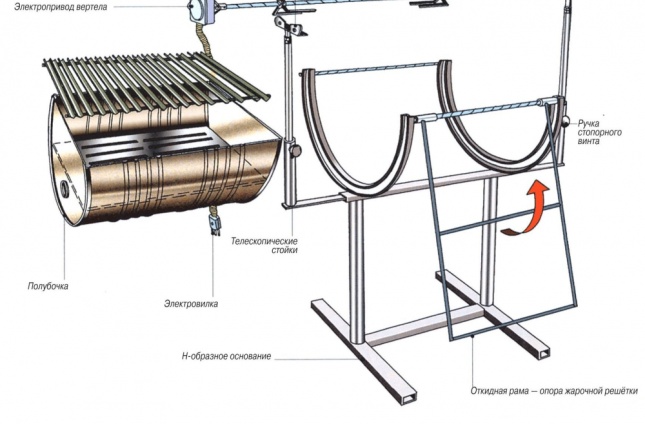
You can also consider the drawings offered on the network: they will help to make useful changes to the proposed version of the barbecue, improve it or simplify the manufacturing process
What is required
In addition to the cylinder itself, such materials will be required:
- pieces of corners and pipes made of steel;
- door hinges;
- metal handles (they are needed for the cover);
- for the chimney: pipe with a bend (at an angle of 90 degrees) - diameter 100 mm;
- bolts and nuts;
- materials for decorating and finishing the structure - primer, paint thinner, selected decor, etc.
Of the tools you need:
- welding transformer;
- grinder (angle grinder), as well as a cleaning and cutting discs for it;
- electrodes with a diameter of 3-4 mm;
- electric drill and drill for metal;
- clamps - are necessary for fixing parts made of metal;
- long metal ruler;
- core;
- brushes for painting the barbecue (you can also use the nozzle in the form of a brush on the drill to simplify the painting process);
- gas, adjustable spanners and a set of wrenches.
Cylinder selection
A cylinder capacity of 50 liters is suitable. Its design allows the use of skewers to the full length, and therefore faster to cook for a large number of people.
If you need a mobile and light brazier, take a 27 liter cylinder.
The wall thickness of such containers is at least three millimeters, so even those products that have been on the street for a long time can most likely be used. The main thing is to check for corrosion. If it is, it is better not to take such a cylinder.
Safety precautions when working with cylinders
When working with gas cylinders, follow three simple safety rules:
- Do not use the grinder until you are convinced of the absence of hazardous substances inside the cylinder. The unscrewed valve of the tank and the lack of gas in it is a sign that the pressure inside is already equal to atmospheric, but not always that the cylinder is safe. Often condensate and gasoline remain in it. It is necessary to remove these substances. They do this:
- turn the container over to drain possible residues of hazardous substances;
- return to normal position and fill with water;
- wait 2-3 days;
- liquid is drained - after this the cylinder becomes completely safe to work with it.
- When welding or cutting metal, do not forget to protect your hands, eyes, and use protective clothing.
- Work outdoors or in a spacious and well-ventilated area with no children or pets.
DIY charcoal grill: step by step instructions
The assembly of the structure is best done on a flat platform so that the grill turns out to be stable. The work consists of the following steps:
- Dismantling the valve and marking the cylinder.
- Cutting capacity.
- Leg making and assembly.
- Finishing - painting and other work.
Valve removal and marking
If the valve has not previously been untwisted, this must be done to make sure that there is no gas in the cylinder (perform the above actions with water) and its safe use later. For work, you need an adjustable or gas wrench.
If the shutoff valves do not unscrew in any way, the valve is cut off with a grinder. The resulting hole is used for mounting the chimney, i.e., a pipe is welded to it.
Next, they start marking up places for cutting - one of the most important stages of independent production of barbecue:
- Each tank has a weld along the length - this is the first marking line. From it at a distance of 24 cm on both sides you need to draw with chalk the second and third marking lines: they divide the balloon in half (its diameter is 96 cm). This is conveniently done using a tape measure and a ruler.
- Mark 10 cm to the right and left from the first line, draw two more in parallel (3rd and 4th marking lines). Air holes will be made on them.
- On the upper side of the barbecue make marks for the lid. Add 10 cm to the 3rd line and draw the fifth.
- Step away from the circular welds at the bottom and top of the container 3 cm inward (i.e. towards each other) and draw lines. In these places there is a tape reinforcing the seams, which can not be damaged while cutting the barbecue. Therefore, mark down at a distance from it.
- Divide the 2nd and 3rd lines into equal parts (8–10 cm each). These are marks for drilling skewer holes.
Opening the bottle and making the cap
According to the marking made, the lid is cut out with an angle grinder:
- Install the cutting disc on the angle grinder.
- Cut along the 2nd marking line.
- Cut to circular marks.
- Cut the cover along the 5th marking line.
To subsequently reduce the inconvenience when installing the cover on the body, immediately weld the hinges along the line of the first cut.
Limiters are welded along the circular edges of the structure. They can be made in different ways, for example, from a chain with large rings or corners from steel. The distance at which the lid will open is chosen so that the structure itself does not close and at the same time the lid can be conveniently opened by the handle.
Then do the following:
- Drill holes for skewers below the place of attachment of the lid. First, with the help of a core, make recesses according to the marks made earlier. File drilled areas.
- On the opposite side from the attachment point of the cover, make cuts for skewers using a grinder. They should be half a centimeter wide. Depth - 2 cm.
- Attach the handles to the cover. The easiest and cheapest option is to take a piece of reinforcement or a metal bar and bend it in the form of the letter P.
- Drill air holes (blow-outs) by pre-punching. They can be made on specially marked lines for this at a distance of 10 cm. Another option is staggered between these two marking lines.
Leg Instructions
The resulting brazier must be installed on the legs. There are several ways to do this:
- Weld four corners or pieces of steel pipe to the body. The attachment points of the legs must be marked so that the structure is stable. Recommended barbecue height - no more than one meter from the ground to the level of the holes for skewers.
- To make a frame from a metal pipe (side racks) and semicircular elements from a steel tire welded to the racks. Two parts of the structure are connected by the type of underframe, using a metal profile for this. Next, the brazier body is installed on semicircular parts and welded for reliability.
If you attach metal wheels to the legs of the barbecue, the design will be more mobile.
BBQ finish
The final stage of the work is painting. The best material for this is heat-resistant paint, which is usually used to paint mufflers. Silicone paint is also suitable for finishing barbecues, fireplaces, metal stoves. But these materials are expensive and difficult to apply.
A more affordable option is mineral bitumen resins. Such coatings are practical and durable, but dry for a long time and have an unpleasant odor. To get rid of it, as well as strengthen the coating, you must wait until the composition is sintered, that is, just use the barbecue for the first two or three times idle, without cooking barbecue. Apply material in 3-4 layers. It is important that the previous layer is completely dry.
A homemade design can be unusually decorated, add decorative details and get, for example, a barbecue in the form of a steam locomotive, a piglet, etc.
Photo gallery: unusual versions of homemade barbecues
- Barbecue with cauldron is easy to decorate in the form of a steam locomotive
- One of the easiest options for the unusual design of the barbecue - make it in the form of a pig
- If the legs of the brazier pig are made of thin pipes, for structural stability it is better to strengthen them with transverse inserts
- Brazier body can be decorated, for example, with metal leaves
Other types of cylinder grill
Of these containers also make:
- barbecue with a cauldron - a simple construction of a barbecue, to which the cauldron is welded to the end part;
- a barbecue is a simple construction made of a bottle with a net for food and an area for coals, often without a lid;
- smokehouse - there is a firebox in this building, an important condition for the correct operation of the structure is tightness, which is achieved by removing half the bottom and welding the firebox and chimney;
- smoker - the most complex design of the cylinders, but also the most functional, used as a barbecue or grill, has a smokehouse and barbecue.
Features of using do-it-yourself barbecues
To cook always tasty barbecue on a new home-made grill and increase the life of the structure, do not forget about the simple rules for using this useful structure:
- watch the heat - properly heated coals are red with a gray coating;
- do not turn over the skew often - for uniform baking of meat this needs to be done only twice;
- cook meat in the zone with the highest heat, and vegetables or fish in others;
- do not bring the barbecue into the room, for example, when it started to rain, this will worsen traction, and therefore, increase the amount of carbon monoxide in the air;
- Do not place the construction close to flammable objects;
- do not dispose of ash immediately after use to prevent fire: it smolders up to a day.
Video: how to make a barbecue yourself
To create a brazier from a gas cylinder is not an easy task, although feasible. Even the minimum skills to use the tools necessary for this work will be enough. And even if they are not there, it is never too late to learn something new. The main thing is to carefully read the instructions, follow the recommendations of specialists and always follow safety rules.
